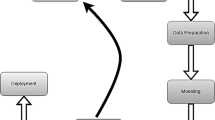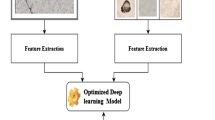Abstract
This paper presents a deep learning-based approach for the detection and classification of production defects that complements an existing thermographic online monitoring system for Automated-Fiber-Placement (AFP) processes. The detection and classification procedure is performed in two stages. In the first stage, the system monitors each tow individually and classifies its process status. Furthermore, it detects and classifies production defects that affect individual tows such as a tow-twist. In the second stage, the system monitors the total width of the faultless tows. In this stage, production defects effecting multiple tows, for example gaps or overlaps, are detected and classified. Twelve different deep convolution neural networks (CNN) with three various architectures are learned supervised relating to different data sets. The performance of both identification stages is explored separately before the entire system will be set up. Therefore, the thermal images of the data sets are superimposed by noise to test the performance of the selected CNN.




Similar content being viewed by others
References
Rudberg T, Neilson J, Henschied M, Cemenska J (2014) Improving AFP cell performance. SAE Int J Aerosp Manuf Autom Fast Conf
Halbritter A, Harper R (2012) Big parts demand big changes to the fiber placement status quo. SME Composites Manufacturing, Mesa
Denkena B, Schmidt C, Völtzer K, Hocke T (2016) Thermographic online monitoring system for automated fiber placement processes. Composite Part B. https://doi.org/10.1016/j.compositesb.2016.04.076
Alexandra K, Linb S, Brabandta D, Böhlkeb T, Lanzaa G (2014) Quality control in the production process of SMC lightweight material. In: Proceedings of the 47th CIRP conference on manufacturing, vol. 47, pp 772–777. https://doi.org/10.1016/j.procir.2014.01.138
Schulz M, Goldbach S, Heuer H, Meyendorf N (2011) Ein Methodenvergleich - ZfP an Kohlefaserverbundwerkstoffen mittels wirbelstrom- und ultraschallbasierender Prüfverfahren. DGZfP, Jahrestagung
Lukaszewicz D (2011) Optimization of high-speed automated layup of thermoset carbon fiber preimpregnates. Dissertation, University of Bristol
Schmidt C, Denkena B, Hocke T, Völtzer K (2017) Thermal imaging as a solution for reliable monitoring of AFP processes, 3. ACM Automated Composites Manufacturing, Montreal rd
Völtzer K (2018) Online process monitoring of the Automated Fiber Placement process based on thermal imaging. Dissertation, Leibniz University Hannover
Weimer D, Scholz-Reiter B, Shpitalni M (2016) Design of deep convolutional neural network architectures for automated feature extraction in industrial inspection. CIRP Ann Manuf Technol 65:417–420. https://doi.org/10.1016/j.cirp.2016.04.072
Masci J, Meier U, Ciresan D, Schmidhuber J, Fricout G (2012) Steel defect classification with Max-Pooling Convolutional Neural Networks. IJCNN. https://doi.org/10.1109/IJCNN.2012.6252468
Simonyan K, Zisserman A (2015) Very deep convolutional networks for large-scale image recognition. ICLR
Mlakic D, Nikolovski S, Majdandzic L (2018) Deep learning method and infrared imaging as a tool for transformer faults detection. J Electr Eng 6:98–106. https://doi.org/10.17265/2328-2223/2018.02.006
Marani R, Palumbo D, Galietti U, Stella E, D’Orazio T (2016) Automatic detection of subsurface defects in composite materials using thermograpgy and unsurpervised machine learning. 8th IS. https://doi.org/10.1109/IS.2016.7737471
Groß L, Herwig A, Berg DC, Schmidt C, Denkena B, Horst P, Meiners D (2018) Production-based design of a hybrid load introduction element for thin-walled CFRP structures. Prod Eng Res Devel 12:113–120. https://doi.org/10.1007/s11740-018-0821-4
Acknowledgements
The authors would like to thank the Federal state of Lower Saxony and the Volkswagen Foundation for funding the research project “Multi-Matrix-Prepreg”. They also thank the Central Innovation Program for SMEs (ZIM) for funding the ongoing research. For further information, visit the website http://www.hpcfk.de.
Funding
Berend Denkena was funded by Zentrales Innovationsprogramm Mittelstand (Grant no. KF2328125PO4) and Volkswagen Foundation (Grant no. ZN3063).
Author information
Authors and Affiliations
Corresponding author
Additional information
Publisher’s Note
Springer Nature remains neutral with regard to jurisdictional claims in published maps and institutional affiliations.
Rights and permissions
About this article
Cite this article
Schmidt, C., Hocke, T. & Denkena, B. Deep learning-based classification of production defects in automated-fiber-placement processes. Prod. Eng. Res. Devel. 13, 501–509 (2019). https://doi.org/10.1007/s11740-019-00893-4
Received:
Accepted:
Published:
Issue Date:
DOI: https://doi.org/10.1007/s11740-019-00893-4




